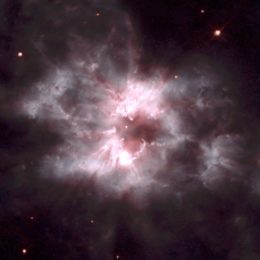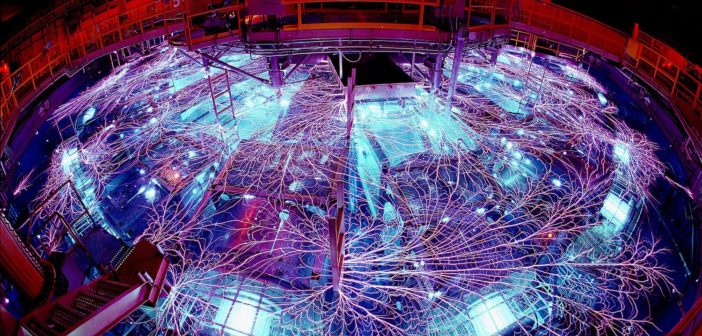Have you ever wanted to examine the photosphere of a white dwarf up close and personal? Now you, too, can recreate and observe the atmospheric conditions of these extreme, dense, dead stars — assuming you have access to Sandia Labs’ Z Machine.
Extreme Cores

The eye-catching planetary nebula NGC 2440 surrounds a newly formed white dwarf star. [NASA/ESA and The Hubble Heritage Team (AURA/STScI)]
White dwarfs are of enormous astronomical use to scientists. By observing white dwarfs, we are able to learn about topics ranging across stellar evolution, mass-loss processes, distances to astronomical objects, and even the age of the universe. To make correct inferences, however, we need accurate measurements of these white dwarfs’ masses — which is easier said than done.
Confusing the Scale
There are multiple techniques that can be used to measure the masses of white dwarfs. One of the most widely used and broadly applicable is spectroscopy: by fitting the absorption lines observed from white dwarfs’ hydrogen atmospheres with line shape models, we can estimate the surface gravity of the white dwarf, which can then be converted into a mass.
The catch? Masses measured this way don’t agree with masses measured using other techniques. So what’s going wrong?

Schematic illustrating the sample cell of hydrogen gas. Incoming X-rays heat the gold wall and backlighter, causing them to emit radiation and turning the hydrogen gas into a dense plasma similar to that of a white dwarf photosphere. Along the red line of sight shown, scientists can measure the absorption spectrum of the plasma. [Schaeuble et al. 2019]
To Create a Star
The Sandia Z machine, located in Albuquerque, New Mexico, is the world’s most powerful radiation source. Using this machine, a team of researchers led by Marc-Andre Schaeuble (Sandia National Laboratories) pummeled a cell of hydrogen gas with high-energy X-rays to produce an extremely hot, dense plasma, simulating the conditions in the photosphere of a white dwarf.
Schaeuble and collaborators measured the absorption spectra that formed as radiation emitted from a backlighter was absorbed by this dense hydrogen plasma. The authors then extracted the atmospheric electron density — a measurement that relates to inferred stellar mass — by fitting hydrogen line shape models to these spectra.
A Discrepancy of Lines

Top: sample line profile fits to the Hβ and Hγ absorption lines using hydrogen line calculations. Bottom: electron density inferred from fits to the Hβ line (red) is consistently higher than that inferred from the Hγ line (blue). [Schaeuble et al. 2019]
Schaeuble and collaborators show that they get a different outcome for the electron density depending on which absorption line the hydrogen line shape models are fit to: from the Hβ absorption line, they infer an electron density that’s >30% higher than that inferred from the Hγ absorption line. This discrepancy would translate into significantly different mass measurements for the same white dwarf.
So which fit — if any — is correct? We don’t know yet! These experiments indicate that current hydrogen line shape models don’t capture all the intricacies at play. By continuing to study white dwarfs — both of the natural and build-your-own varieties — we may yet puzzle it out.
Citation
“Hβ and Hγ Absorption-line Profile Inconsistencies in Laboratory Experiments Performed at White Dwarf Photosphere Conditions,” M.-A. Schaeuble et al 2019 ApJ 885 86. doi:10.3847/1538-4357/ab479d

2 Comments
Pingback: Földi laborban modellezték egy fehér törpe légkörét – Könyv Kuckó
Pingback: 1,000 AAS Nova Highlights and Five Years of Astronomy